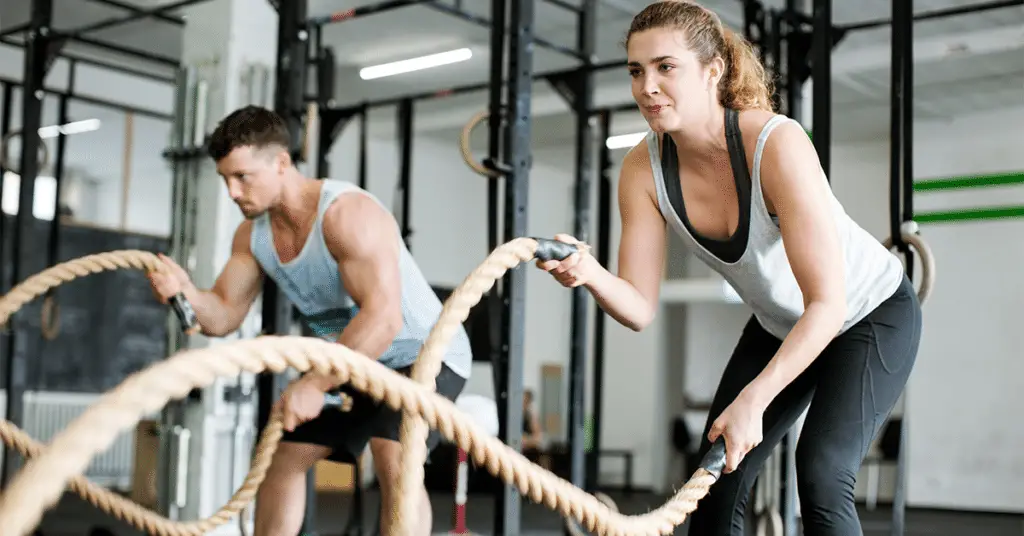Introduction
What Is Crossfit Body:CrossFit is a high-intensity fitness regimen that has revolutionized the world of exercise and strength training. More than just a workout program, CrossFit has evolved into a lifestyle and a community, attracting individuals from all walks of life seeking to improve their physical fitness and overall well-being.At its core, CrossFit is characterized by its emphasis on functional movements performed at high intensity. It incorporates a diverse range of exercises, from weightlifting and gymnastics to cardiovascular workouts and bodyweight exercises, all designed to challenge and improve various aspects of fitness, including strength, endurance, flexibility, and agility.
What sets CrossFit apart from conventional fitness programs is its focus on constantly varied workouts, meaning no two sessions are the same. This approach not only prevents boredom but also keeps the body adapting and progressing. CrossFit’s communal nature, often conducted in group classes, fosters camaraderie and friendly competition among participants, creating a supportive environment that encourages pushing one’s limits.
In this introduction, we will delve deeper into the world of CrossFit, exploring its origins, principles, benefits, and the diverse community it has cultivated worldwide. Whether you’re an elite athlete or a fitness novice, CrossFit offers a challenging and rewarding path to achieving your health and fitness goals.
CrossFit, founded by Greg Glassman and Lauren Jenai in the early 2000s, has rapidly gained popularity for its effectiveness in producing well-rounded athletes and its ability to transform individuals into the best versions of themselves. The CrossFit methodology goes beyond mere physical training; it places equal importance on mental resilience, discipline, and adaptability.

What is a CrossFit body type?
Probably mesomorphs. This body type has a medium frame and is solidly built. If you’re a mesomorph, you’re prolly a little faster or better than average when it comes to strength training. Endomorphs (shorter, rounder body types) and ectomorphs (tall, slim body types) can still enjoy and excel at CrossFit.
CrossFit is a fitness program that is inclusive and adaptive to various body types and fitness levels. It doesn’t emphasize or prioritize any specific body type. Instead, CrossFit encourages individuals of all body types to participate and excel in its workouts. The effectiveness of CrossFit is not limited to any particular body type, and people with diverse body compositions can achieve success in CrossFit.
That said, some individuals may find certain aspects of CrossFit workouts more naturally suited to their body types. For example, mesomorphs, who tend to have a medium frame and good muscle development, might excel in strength-related CrossFit exercises. However, CrossFit’s diverse programming includes elements of cardiovascular fitness, gymnastics, and agility, which can benefit individuals with different body types as well.
What does CrossFit do for the body?
CrossFit is a form of high-intensity interval training and comparable to other high-intensity exercises. CrossFit exercises increase VO2max, strength, endurance, and improves the body composition (e. g. lean body mass).CrossFit is a comprehensive and intense fitness program that offers a wide range of benefits for the body.
Here are some of the key effects and advantages of CrossFit training:
Increased VO2max: CrossFit involves a combination of cardiovascular and strength exercises performed at high intensity. This can lead to improvements in VO2max, which is the maximum amount of oxygen a person can use during intense exercise. Enhanced VO2max reflects improved cardiovascular fitness and endurance.
Strength Gains: CrossFit incorporates a variety of functional movements, such as weightlifting, bodyweight exercises, and gymnastics. These exercises help develop overall strength, targeting both major muscle groups and stabilizer muscles.
Muscular Endurance: CrossFit workouts often involve high-repetition, high-intensity movements, which can significantly improve muscular endurance. This is particularly beneficial for sports and activities that require prolonged exertion.
Body Composition: CrossFit can contribute to changes in body composition by increasing lean body mass and reducing body fat percentage. The combination of strength training and high-intensity cardio workouts can help individuals achieve a leaner and more toned physique.
Improved Agility and Flexibility: CrossFit incorporates movements that enhance agility, balance, and coordination. Additionally, regular training can lead to improved flexibility, which is essential for preventing injuries and optimizing overall athletic performance.
What is CrossFit body vs workout body?
Crossfit workouts will help you burn more calories, boost endurance, build up and tone muscles, and improve body shape. On the other hand, gym workouts will help you increase strength and beef up muscle mass more than CrossFit. So depending on your fitness level, you can do one of them.The terms “CrossFit body” and “workout body” are not typically used in formal fitness terminology, but it seems you are referring to the physical outcomes and benefits associated with different types of training approaches, specifically CrossFit and traditional gym workouts.
Here’s a breakdown of the differences you mentioned:
CrossFit Body:
CrossFit workouts are known for their high-intensity, functional movements, and varied exercises.
Benefits of CrossFit often include improved cardiovascular fitness, endurance, muscle toning, and overall body composition.
CrossFit can help individuals burn calories efficiently, which can lead to weight loss and a leaner physique.
CrossFit tends to emphasize a balance between strength, agility, and cardiovascular fitness.
It often results in a more functional and athletic physique that is adaptable to various physical challenges.
Workout Body (Traditional Gym Workouts):
Traditional gym workouts can be tailored to specific goals, such as increasing strength and muscle mass.
Gym workouts often involve weightlifting and resistance training exercises, which are effective for building muscle and strength.
They may not be as focused on high-intensity cardio as CrossFit but can still improve cardiovascular fitness.
Gym workouts can lead to increased muscle size and a more “bulked up” appearance, especially when combined with proper nutrition and progressive overload in lifting.
Traditional gym workouts can be customized to target specific muscle groups and can be tailored to bodybuilding or powerlifting goals.
Is CrossFit full body?
It does not matter if you want to improve your health and get in shape, shed a few pounds, defy your age, or increase your body’s performance, CrossFit is a full-body workout that can help. It is an appropriate option for those that are just starting out and those that have years of experience in training and exercise.Yes, CrossFit is indeed a full-body workout. It is designed to engage and challenge all major muscle groups in the body, providing a comprehensive and well-rounded fitness experience. CrossFit workouts typically incorporate a wide variety of functional movements, including weightlifting, bodyweight exercises, cardiovascular conditioning, and more, all of which target different areas of the body.
Here are some reasons why CrossFit is considered a full-body workout:
Functional Movements: CrossFit emphasizes functional movements that mimic real-life activities. These movements engage multiple muscle groups simultaneously, ensuring that no part of the body is left untrained.
Compound Exercises: Many CrossFit exercises are compound movements that involve multiple joints and muscle groups working together. Examples include squats, deadlifts, and overhead presses, which recruit muscles from head to toe.
Cardiovascular Conditioning: CrossFit workouts often incorporate high-intensity interval training (HIIT), which challenges the cardiovascular system and works the entire body.
Core Engagement: Core strength and stability are essential in CrossFit, and many exercises, such as kettlebell swings and wall balls, require strong core activation.
Variety: CrossFit programming is known for its variety and constantly changing workouts (WODs). This variety ensures that different muscle groups are targeted over time, preventing plateaus and promoting balanced development.
What is the CrossFit body weight routine?
20 Min EMOM.
Minute 1: 12 Jump Squats.
Minute 2: 12 Burpees.
Minute 3: 12 Handstand Push-ups.
4 Rounds For Time.
8 Burpee Over Obstacles.
16 Handstand Push-ups.
12 Min AMRAP.
1 Strict Handstand Push-ups.
3 Jump Squats.
3 Rounds For Time.
25m Handstand Walk.
20 Pistol Squats.The CrossFit bodyweight routine you’ve provided consists of a series of exercises that can be done without the need for any equipment or weights. This routine is structured as a combination of different workouts and formats, including EMOM (Every Minute on the Minute), rounds for time, and AMRAP (As Many Rounds As Possible).
Here’s a breakdown of the exercises and structure:
EMOM (20 minutes):
Minute 1: 12 Jump Squats
Minute 2: 12 Burpees
Minute 3: 12 Handstand Push-ups
In an EMOM, you perform the prescribed exercises at the start of each minute and use the remaining time in that minute as your rest period. You’ll cycle through these three exercises for 20 minutes.
Rounds for Time (4 rounds):
8 Burpee Over Obstacles
16 Handstand Push-ups
In this format, you complete all the reps for each exercise before moving on to the next exercise. The goal is to complete all four rounds as quickly as possible.
AMRAP (12 minutes):
1 Strict Handstand Push-up
3 Jump Squats
In an AMRAP, you perform as many rounds of the specified exercises as you can within the given time frame, which is 12 minutes in this case.
Rounds for Time (3 rounds):
25m Handstand Walk
20 Pistol Squats
Similar to the previous “Rounds for Time” section, you complete all the reps for each exercise before moving on to the next exercise. The goal is to complete all three rounds as quickly as possible.
Is CrossFit good for a lean body?
For some people, CrossFit is good for weight loss. Its high-intensity workouts boost metabolism and can burn a lot of calories, and they’re efficient, which is great for busy people.Yes, CrossFit can be effective for achieving and maintaining a lean body, but it’s important to understand how it contributes to this goal.
High-Intensity Workouts: CrossFit workouts are known for their high intensity. This intensity can lead to a significant calorie burn during and after the workout, which is essential for weight loss and achieving a leaner body.
Metabolic Boost: CrossFit workouts often incorporate elements of high-intensity interval training (HIIT), which has been shown to boost metabolism and increase calorie expenditure even after the workout has ended. This is known as the “afterburn effect” or excess post-exercise oxygen consumption (EPOC).
Muscle Development: CrossFit includes a combination of strength and conditioning exercises that help build lean muscle mass. Muscle tissue burns more calories at rest than fat tissue, contributing to a higher basal metabolic rate (BMR) and aiding in weight management.
Body Composition: CrossFit can improve body composition by reducing body fat percentage and increasing lean muscle mass. This results in a more toned and defined physique associated with a lean body.
Efficiency: CrossFit workouts are typically time-efficient, making them suitable for individuals with busy schedules. Short, intense sessions can provide substantial fitness benefits, including weight loss.
Is CrossFit good for body fat?
CrossFit workouts also involve high-intensity interval training (HIIT), which is effective for weight loss. HIIT involves short bursts of intense exercise followed by periods of rest, and studies have shown that it can help burn more fat than steady-state cardio.Yes, CrossFit can be effective for reducing body fat and promoting weight loss for several reasons.
High-Intensity Workouts: CrossFit workouts are known for their high intensity. They often incorporate functional movements, weightlifting, and cardio exercises at a vigorous pace. These intense workouts can lead to a high calorie burn, which is essential for fat loss.
Metabolic Conditioning: CrossFit includes metabolic conditioning (MetCon) workouts that are designed to boost metabolism and improve cardiovascular fitness. These workouts often involve high-intensity interval training (HIIT), which has been shown to be effective for burning fat. HIIT alternates between short bursts of intense exercise and brief rest periods, which can lead to increased fat oxidation.
Strength Training: CrossFit incorporates strength training exercises, such as weight lifting and bodyweight movements. Building and maintaining lean muscle mass through strength training can increase your resting metabolic rate, meaning you burn more calories even when you’re not exercising.
Varied Workouts: CrossFit’s constantly varied programming keeps workouts interesting and challenging. This variation can prevent workout plateaus and stimulate fat loss by continuously challenging your body in new ways.
Community and Accountability: Many CrossFit gyms foster a sense of community and accountability, which can help individuals stay motivated and consistent with their training and nutrition goals.
What are CrossFit workouts called?
Many people unfamiliar with CrossFit have asked that question. Well, it’s actually spelled “WOD,” it stands for “Workout of the Day,” and thousands of people all around the world complete it every day, getting fitter and having fun doing it.
In CrossFit, workouts are commonly referred to as “WODs,” which stands for “Workout of the Day.” The WOD is a central component of CrossFit programming and represents the daily workout challenge that participants tackle. Each day, a new WOD is posted at CrossFit gyms, on CrossFit websites, and in CrossFit communities worldwide. These workouts vary in terms of exercises, intensity, duration, and goals, and they are designed to continually challenge participants and promote overall fitness and functional strength. The concept of the “WORLD” is at the heart of the CrossFit community, fostering a sense of camaraderie as individuals come together to complete the same workout and share their results and experiences. It adds an element of variety and surprise to the training, keeping participants engaged and motivated in their fitness journey.

Conclusion
The term “CrossFit body” doesn’t refer to a specific body type but rather embodies a wide range of physical attributes and capabilities cultivated through CrossFit training. CrossFit is a fitness methodology that promotes functional fitness, focusing on building strength, endurance, agility, and overall athleticism. It’s a training approach that welcomes individuals of all body types and fitness levels.
CrossFit emphasizes well-rounded fitness, encouraging participants to excel in various domains, from weightlifting and gymnastics to cardiovascular endurance. While it can result in improved body composition, including reduced body fat and increased lean muscle, the ultimate goal is to develop a versatile and adaptable physique capable of handling diverse physical challenges.
The so-called “CrossFit body” is not defined by appearance alone but by one’s ability to perform functional movements efficiently and to continuously challenge and improve their fitness across multiple dimensions. It’s a testament to the inclusive and diverse nature of CrossFit, where individuals strive to be the best versions of themselves, regardless of their starting point, and to achieve optimal health and fitness.

